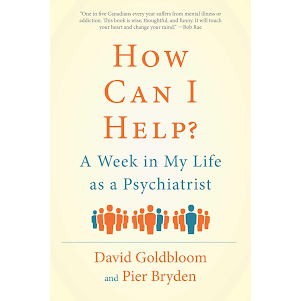by David Goldbloom and Pier Bryden; 2013
Book review
by Peter McKenzie-Brown; September 25th, 2023.
Lately, the
best reads I get have come from one of the many Little Libraries (book boxes)
around town. That applies to the book I’m reporting on this month. Once I
started reading, I was hooked.
The downside
was that I lent it to a friend who promptly went on holiday. To show you the
book today, I had to order it from the library. I knew it would be available,
because it was a non-fiction bestseller across Canada.
A psychiatrist,
David Goldbloom is a senior medical adviser at the Centre for Addiction and
Mental Health in Toronto. He and co-author Pier Bryden, who is also a psychiatrist,
seek to reduce public fear of psychiatry by showing what they really do, the
conditions they treat, the resources they deploy and the settings in which they
work.
Tracking
Goldbloom over the course of a hypothetical week gives the reader a bird’s-eye
view of what psychiatrists in a teaching hospital do, providing a textured
picture of its complexity. In this book the reader observes Goldbloom diagnosing
and critiquing a diagnostic interview, meeting with long-standing patients to
monitor their symptoms and medication, teaching residents, administering
electroconvulsive therapy, and confirming a diagnosis of Asperger's disorder by
long-distance telepsychiatry to Kenora, Ontario, and admitting an involuntary
schizophrenic patient to the acute care unit. Those activities all take place
on a single morning.
Some of the
patients profiled gave explicit permission to appear in the book as themselves;
others are fictionalized composites. Whichever category they fall into, all seem
equally real. Goldbloom's genuine and sensitive engagement with his patients is
moving to behold. Yet a great many of the bonds he ha- with his clients are
based on that recognition that are virtually no cures for what this book
describes as the three major psychiatric disorders: bipolar disorder, schizophrenia,
and depression. In these cases, the challenge is to restore mental health when
relapses occur, extend periods between episodes by facilitating emotional,
vocational, cognitive, and other strengths, bolster social supports, and offer
hope.
The book
explains many of the biases that exert internal pressure on him when he's
trying to remain on an even clinical keel. More impressive is the way he frames
his professional story with his personal life. While immersing himself in the
moods, thoughts, worries and preoccupations of his patients, the same processes
are pressuring him. All physicians are subject to emotional vicissitudes, but
most specialists are not trying to treat these same intense fluctuations in
others while trying to cope with their own. Goldbloom's extra measure of
personal exposure makes it clear that psychiatrists and other physicians are
not exactly exempt from human emotions.
Shouldn’t psychiatrists
be able to manage their internal challenges with introspection, insight, and
other techniques? Well, yes. But in one case he mentions, Goldbloom is so
distraught by the news that one of his patients has committed suicide that he
rallies many resources to regain emotional equilibrium, including paying a
condolence call to his patient's family in which their shared grief helps all
of those present to heal.
This book
is beautifully written. Although there are two authors, most paragraphs are written
in the first person: I did this, I saw that, I asked how, and so on. Throughout
the book, the first person clearly seems to be Goldbloom. This confused me a
bit, in the sense that Ms. Bryden is the co-author, yet no segment of the book
seems to directly represent her own point of view. Odd though it may seem, the
consistency of this approach contributes to the book’s readability.
Throughout
the book, the authors refer to the literature that helped create modern
psychiatry, much of it originating in the 19th Century. I’ll close
with a story from that century about a young woman who had the mental condition
known as anorexia nervosa, which is mostly a female syndrome, in which
the patient refuses to eat. To give an example, he cites the story of Sarah
Jacobs, who stopped eating normally as she entered puberty. I’ll close these comments
with her story:
[Sarah] claimed to need no form of nourishment
and became a tourist attraction, bringing her family money and fame. A medical
team was sent to observe this apparent miracle, providing nurses to watch Sarah
around the clock and ensure that she wasn’t surreptitiously given any food or
water. After six days of this, Sarah was clearly failing, and the nurses appealed
to the doctors on the team and to Sarah’s father to feed the girl. Mr. Jacobs
refused, presumably determined that the family’s golden goose not be slaughtered,
and after ten days of observation, Sarah died.
This book
is powerful; I rank it a Canadian masterpiece. Every page is a
source of knowledge and wisdom. It is worth savouring.

No comments:
Post a Comment